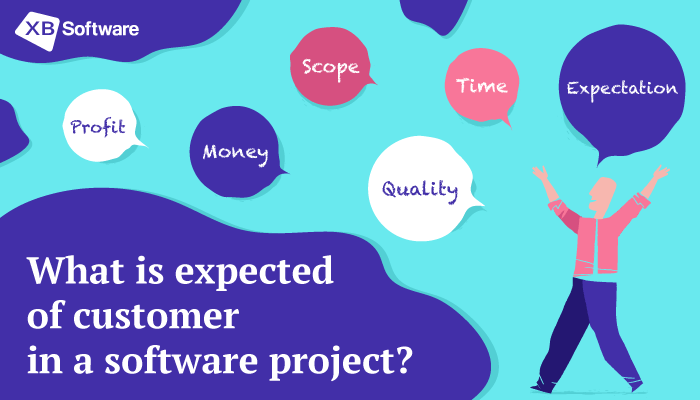Dealing with a web app development company for the first time can be a harsh experience for any customer. Even if you’re dealing with an experienced software vendor, the positive outcome is not guaranteed when you’re not ready to participate in the development process at all stages. Besides providing the development company with the list of project requirements, there’s a need for constant participation on your part.
In this article, we’ll consider the main client’s responsibilities in a software project that should be kept in mind when cooperating with a software development company. Following this simple advice, you can increase the probability of a positive outcome.

Define Project Requirements as Clearly as Possible
Even though this advice seems very obvious to be mentioned separately, sometimes it’s hard for the customer to define the exact amount of software project requirements that have to be formulated to reach the desired result. The more scrupulous the development plan’s discussion will be, the better product you’ll get eventually. After reaching an agreement with your software vendor, ensure that all stakeholders understand the need to follow the plan during the whole project development process.
When a customer formulates the project requirements, there are usually the following options to choose:
- Unstructured business requirements. In this case, all project requirements are formulated during the process of discussion between the customer and other stakeholders. Such a process can take various forms. For example, business analysts from the software development company can conduct an interview. The results of such collaboration will help to create a list of project requirements to be approved by a customer.
- Structured business requirements. As a customer, you can provide the software development company with the business documentation that will help to answer the following questions: “Who is the customer and what business activities he’s involved in?”, “What goals does the customer want to reach?”, “What’s the problem with the solution that is currently used by a customer?” and more. Besides that, such documentation may include some additional info on stakeholders, product actors, and some key quality project requirements. For example, you can demand that the main page of your app should load approximately 300ms.
- Structured business requirements plus additional details. In this scenario, a customer is free to add more details to structured business requirements. Business requirements describe the main goals that allow a customer’s company to reach the competitive advantage in the market. Details, in turn, are related to the specific preferences of the end-user. To define such details properly, you have to involve some end-users that will utilize the application after it’s ready. For example, you can interview your employees to learn more about the problems they face during the working process and understand their expectations for the future software project.
Sometimes a customer already has an existing application that is not satisfactory for some reason. In such a case, it’s necessary to provide the development company with all the info on that solution and strictly formulate what changes should be implemented during the development process (app modernization, development and integration of a new module, UX/UI design and development, etc.).
Clarify as Many Details as Possible
Even if a customer has provided a software vendor with the detailed list of project requirements, there’s always some obscurities that may appear during the project development process. Therefore, it’s important for a customer to feel free to ask clarifying questions at all project stages.
It’s essential to stay in touch with the software development company and always be ready to ask or answer additional questions that may (and will) appear at some point. A customer must be ready to give clear answers as fast as possible to avoid delays in the software development process and reach the best outcome.
Constantly Review Deliverables
Each stage of the software project development process provides different user-related deliverables such as user interface mockups, prototypes, intermediate versions of software, etc. Besides that, there are some technical deliverables, including documentation and source code, for example. Hiring a business analyst (BA) or project manager (PM) is a great option to take off the lion’s share of responsibilities related to deliverables. Nevertheless, as a customer, you should constantly check and approve these developer’s work results. Communication issues may arise during the project life cycle if you work with a large team of specialists. In this case, for a client with little experience of cooperating with a custom software developer, it may be hard to define who’s in charge of project requirements, design, various technical questions, etc. PM or BA can determine which exact team member you should contact to receive relevant and most accurate information. Choosing the right communication channels is another essential concern that PMs and BAs can take care of. This part of the work should not be ignored since it includes dozens of crucial aspects. Communication tools should be handy and allow you to establish a connection with the needed specialists quickly. Online meetings, chats, collaboration on design, effective tasks tracking, and many other tiny pieces should be kept in mind while developing the plan communication. Choosing the tech stack that better suits a client’s needs is another essential task usually performed by PMs and BAs. Also, it’s pretty important not to underestimate different types of software testing, starting from the first stages of development. For example, early prototype testing allows detecting issues, while their solving is relatively inexpensive.
Read also Role of a Project Manager in a Software Development Project
Sometimes it may be hard to define whether these intermediate deliverables meet the initial customer’s expectations or not, especially in case it’s your first experience of cooperating with a software vendor. In such a case, it’s possible to consider the opinion of hired independent reviewers.
Being fully involved in the software project and providing regular feedback during the development process, a customer motivates the development team to provide better results. Moreover, accepting low-quality deliverables, you can mislead the development company and impact the contractual terms and conditions. It’s a pretty usual situation when the software project requires being reworked at additional costs after the acceptance of intermediate deliverables.
A customer should meet the development team regularly to kick off development with high expectations. It may be pretty helpful to schedule weekly (or more frequent) video/audio calls with team members or stakeholders that will help to provide prompt feedback or clarify some questions that may arise during the work on the project. Also, it’ll be a good opportunity to ask the development team as many questions as you need.
Risk Management Is the Must
Every customer must spend enough time and effort to deal with risk identification and management. Some development companies can be too optimistic which can lead to underestimation of possible project risks.
There is a certain risk on the customer’s side as well. If you hire a software development company from abroad, you must keep in mind that there may be some laws and regulations that are specific to your country about which your software vendor is not aware. Besides that, local industry regulations may change at some point leading to unexpected issues.
Conclusions
The first experience of collaboration with a development company can be a tricky thing. Besides the absence of knowledge that allows answering the obvious question “How to choose a software development firm?” there may be other factors. For example, without understanding the client’s responsibilities in the project development process, you might not know what is expected of you as a customer.
The main thing that should be kept in mind is that you shouldn’t let things go by themselves. As a customer, remember that it’s important to start participating in the development process long before the first line of code is written.
The phase of requirements gathering should include a series of interviews with your employees to formulate what results you expect to get. After the development process is started, the worst thing to do is simply wait for the software project to be finished. At all stages of the development process, a customer should monitor the process and check the deliverables provided by the development company. It will help to clarify additional project requirements and assure that the resulting product or service will meet your expectations.

